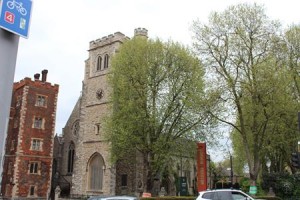 On this day in history, 7th April 1538, Elizabeth Boleyn, Countess of Wiltshire and Ormond, was laid to rest at St Mary’s Church in Lambeth.
On this day in history, 7th April 1538, Elizabeth Boleyn, Countess of Wiltshire and Ormond, was laid to rest at St Mary’s Church in Lambeth.
Elizabeth was the mother of the late Queen Anne Boleyn and George Boleyn, Lord Rochford, as well as the surviving Mary Stafford (née Boleyn). She had lost two children in infancy: Thomas and Henry. Elizabeth was the wife of Thomas Boleyn, Earl of Wiltshire and Ormond, the former Lord Privy Seal, who outlived her by just under a year.
Elizabeth was laid to rest in the Howard Chapel of St Mary’s Church, Lambeth, which is next to Lambeth Palace.
John Husee recorded her funeral procession in a letter to Lady Lisle, who was in Calais:
“My lady Wiltshire was buried at Lamehithe on the 7th… She was conveyed from a house beside Baynard’s Castle by barge to Lambeth with torches burning and four baneys (banners?) set out of all quarters of the barge, which was covered with black and a white cross.”1
Sir John Russell, Lord Comptroller, acted as the chief male mourner and Elizabeth’s half-sister, Katherine Howard, Lady Daubenay, was the chief female mourner. J. Nichols, in History of the Parish of Lambeth (1786), stated that there used to be a brass plate at St Mary’s Church, Lambeth, which was inscribed “Here lyeth the Lady Elizabeth Howard, some time Countess of Wiltshire”, but it no longer exists.
In the 1970s, St Mary’s was saved from demolition and became the Museum of Garden History, known now as the Garden Museum. The Howard Chapel is now the café and Elizabeth’s resting place is somewhere beneath the wooden floor. It is wonderful that the church was saved.
Here is a slideshow of photos I took at Lambeth. It includes photos of the exterior of Lambeth Palace (the red brick building) and the exterior and interior of the Garden Museum (formerly St Mary’s Church), including the café/Howard Chapel.
[slideshow id=580 w=450 h=300]
You can read more about the Howard Chapel in Marilyn Roberts’ article – click here.
Notes and Sources
- Letters and Papers, Foreign and Domestic, Henry VIII, XIII, Part 1, 696 717.
- Nichols, J (1786) History of the Parish of Lambeth.